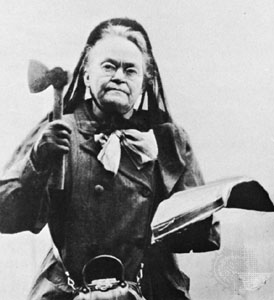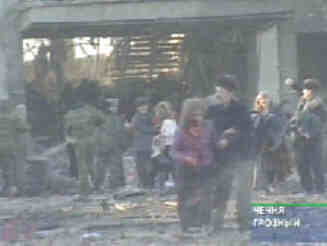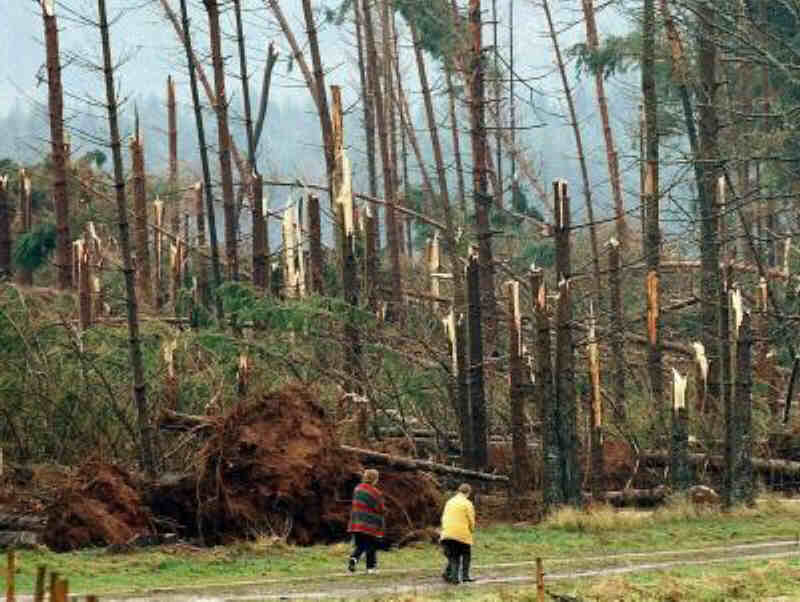 1899
Carry Nation attacks her first saloon. 1899
Carry Nation attacks her first saloon.After moving to Medicine Lodge, Kansas, Carry Amelia (Moore) Nation was outraged that the Kansas "dry" laws were not being enforced. For several years she was an outspoken camapaigner of the Women's Christian Temperance Union, of which she and Mrs. Wesley Chain, wife of the Baptist minister, organized a chapter in Medicine Lodge during the 1890's. But she finally decided that words were not enough. So, on this afternoon, after a day of prayer, Carry Nation, 53, and Mrs. Cain put on their best dresses and bonnets and start out. Men, women and children promptly fall in behind the crusaders to see what is going to happen, and when they reach Mort Strong's saloon, they are surrounded by more than 200 persons. As Carry starts to go inside, armed with no more than an umbrella, the town constable steps up and says, "I wish I could take you off the streets. “ — "Yes," she replied, "you want to take, me a woman whose heart is breaking to see the ruin of these men, the desolate homes and broken laws — and you, a constable, oath-bound to close this man's unlawful business!" Carry steps forward, pushes aside the swinging doors and strides into the saloon. She has gone no farther than the front room when Strong hurries from the bar, takes her by the shoulders, turns her around and regardless of her shrieks, pushes her back into the street. With tears streaming from her eyes, Carry Nation continues alternately to sing and hurl curses at the saloon keeper, and Mrs. Cain and half dozen other women joined in the song. Their shrill voices carry over town, and soon the crowd about the saloon numbers some 500. Some encourage her, while others shout defiance. After several more unsuccessful attempts to enter the saloon, Mrs. Nation starts off toward home, singing. Behind her come Mrs. Cain, and an ever increasing stream of women. At Carry's home, throughout the remainder of the afternoon, the excited women sing, pray and rejoice over the downfall of the saloon, while a crowd hangs about outside and called for more action. That evening, there is great excitement throughout town and finally the rumor is passed about that Strong has horse-whipped a woman. Finally, about midnight, the mayor and several councilmen go in a body to Strong's place and express surprise and indignation at finding beer and whisky on the premises. They sternly tell Strong that he must leave town at once or take the consequences. He leaves the next morning, and Carry Nation rejoices that are were only six saloons remaining in her town. Carry Nation would go on to on similar rampages in Wichita and Topeka, and in other cities in Iowa and Illinois as well. She would go armed with a bag of rocks and, starting on 21 January 1901, with her trade-mark hatchet. After her rather brief "hatchetation" period, which brought her national notoriety, she continued to rail against not only alcohol, but also fraternal orders, tobacco, foreign foods, corsets, skirts of improper length, and mildly pornographic art of the sort found in some barrooms of the time. She was also an advocate of woman suffrage. Despite her campaign, the enactment in 1919 of national prohibition was largely the result of the efforts of more conventional reformers, who had been reluctant to support her. She died on 9 June 1911. NATION ONLINE: her 1904 autobiography, The Use and Need of the Life of Carry A. Nation, The Use and Need of the Life of Carry A. Nation |
1874 Alfonso XII, rey de España, accede al trono español gracias al golpe de Estado que protagoniza el general Martínez Campos.
1870 El general Juan Prim y Prats, presidente del Gobierno español, sufre un atentado en Madrid y fallece tres días después a causa de las heridas de bala recibidas.
1867 Ontario and Québec legislatures hold 1st meeting.
| 1864 Reb Army of Tennessee retreats,
defeated. General John Bell Hood's broken and defeated Confederate Army of Tennessee finishes crossing the Tennessee River, retreating into Mississippi. The last half of 1864 was a disaster for the army. In May, Union General William T. Sherman began his drive on Atlanta from Chattanooga, Tennessee. The Confederate army was commanded then by Joseph Johnston, who responded to Sherman's flanking maneuvers by retreating slightly each time. From May to July, Johnston slowly backed into Atlanta, exchanging territory for time. When the troops reached Atlanta, Confederate President Jefferson Davis replaced Johnston with the offensive minded Hood. Hood immediately attacked Sherman three times in late July, losing each time. His offensive capabilities spent, Hood endured a monthlong siege of Atlanta. In early September, Hood was finally forced to relinquish the city to Sherman. Hood hung around to try cutting into Sherman's supply lines but then retreated into Alabama. In November, Hood tried to draw Sherman from the deep South by moving towards Nashville, Tennessee. In response, Sherman dispatched part of his army back to Tennessee while taking the rest on his devastating march across Georgia, during which the Yankees destroyed nearly everything in their path. Hood moved north and fought two battles that were disastrous for the Confederates. At Franklin on 30 November 1864, Confederate attacks on entrenched Union soldiers resulted in ghastly Confederate casualties and the loss of six of the army's finest generals. On 15 and 16 December 1864, the Confederates were crushed by the Yankees in front of Nashville. The dwindling numbers of participating soldiers tell the sad story of the Rebel army. In May, some 65'000 Confederates faced Sherman in northern Georgia. On 20 September, after Atlanta fell, Hood's force numbered 40'403. After crossing the Tennessee River, Hood reported 18'708 officers and enlisted men, a figure that another Confederate general, Pierre Beauregard, thought was significantly inflated. The Confederate Army of Tennessee was no longer a viable fighting force. |
| 1846 Doniphan's Thousand take
El Paso del Norte from Mexicans. The rag-tag army of volunteers known as Doniphan's Thousand, led by Colonel Alexander W. Doniphan, wins a major victory in the war with Mexico with the occupation of El Paso. Born in Kentucky in 1808, Doniphan moved to Missouri in 1830 to practice law. But the tall redheaded man was not satisfied with fighting only courtroom battles, and he volunteered as a brigadier general in the Missouri militia. When war between Mexico and the US erupted in 1846, the men of the 1st Missouri Mounted Volunteers elected Doniphan their colonel, and marched south to join General Stephen Kearny's army in New Mexico. Since they were not professional military men, Doniphan's troops cared little for the traditional spit-and-polish of the regular troops, and reportedly looked more like tramps than soldiers. Likewise, Doniphan was a casual officer who led more by example than by strict discipline. Nonetheless, Doniphan's Thousand proved to be a surprisingly effective force in the war with Mexico. In December, Doniphan led 500 of his men and a large wagon train of supplies south to join General John E. Wool in his planned invasion of the Mexican state of Chihuahua. Before he had a chance to meet up with Wool's larger force near the city of Chihuahua, Doniphan encountered an army of 1200 Mexican soldiers about 50 km north of El Paso del Norte, the Mexican city now called Ciudad Juares, on the south bank of the Rio Grande (El Paso, Texas, on the northern bank, did not yet exist). Although his opponents had twice the number of soldiers, Doniphan led his men to victory, and with the path to El Paso now largely undefended was able to occupy the city two days later. When nearing the Mexican border, Doniphan learned that General Wool's forces had broken off their invasion of Chihuahua because the army's wheeled vehicles had proved unworkable in the desert landscape. But rather than turn back, Doniphan reassembled his army to its full force of about 1000 men and was allowed to proceed with the invasion unassisted. Once again grossly outnumbered--the Mexican army was four times the size of Doniphan's--the Missouri troops were still able to quickly break through the defensive lines and occupy Chihuahua City. By mid-summer 1847, Doniphan's victorious army reached the Gulf Coast, where they were picked up by ships and taken to New Orleans for discharge. By then, the focus of the battle had shifted to General Winfield Scott's campaign to take Mexico City. In September of that year, Scott's troops ended the war by successfully occupying Mexico City, and for the first time in US history an American flag flew over a foreign capital. The Treaty of Guadalupe Hidalgo, signed early in 1848, gave the US the vast western territory stretching from Texas to the Pacific and north to Oregon |

 Deaths
Deaths